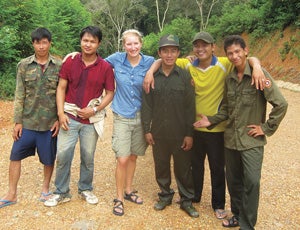Saving Endangered Gibbons
 It’s a long way from Professor Jim Loy’s biological anthropology class, but Julia Ruppell ’04 is in Laos, her seventh trip to Southeast Asia. She’s conducting research on the white-cheeked crested gibbon, one of the world’s most understudied and endangered mammals. A Fulbright scholarship will help fund her project.
It’s a long way from Professor Jim Loy’s biological anthropology class, but Julia Ruppell ’04 is in Laos, her seventh trip to Southeast Asia. She’s conducting research on the white-cheeked crested gibbon, one of the world’s most understudied and endangered mammals. A Fulbright scholarship will help fund her project.
Her study involves not only helping the gibbons, but engaging with local residents and students to teach them about global conservation. She is shown here with her Lao research team field (from left) Tsing, Souliya, Dua, Somphet, and Suree.
Because Laos is so mountainous and isolated, there are a lot of areas where gibbons survive. However, industrialization and development have created rapid changes in recent years, causing widespread habitat fragmentation for the gibbons,” she says.
 “Ruppell’s research is part of her doctoral dissertation in biology at Portland State University where she earned a master’s degree in biological anthropology.
“Ruppell’s research is part of her doctoral dissertation in biology at Portland State University where she earned a master’s degree in biological anthropology.
“Gibbons are one of the few primates to sing,” says one of the ape’s biggest fans. “An adult male and female live together with their offspring in a territory they defend by singing. The male sings for several minutes, then the female chimes in with a great call of notes that become louder and increase in siren-like frequency.”
 Home
Home Browse
Browse Close
Close Events
Events Maps
Maps Email
Email Brightspace
Brightspace eCampus
eCampus


